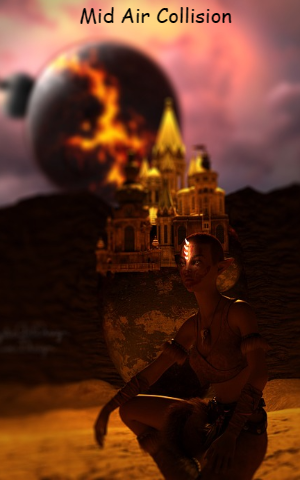Mid Air Collision
Mid Air Collision


INDIRA GANDHI INTERNATIONAL AIRPORT, DELHI
12 NOVEMBER 1996
3:55 AM
Around 3:55 AM on 12th November 1996, Kazakhstan’s chartered airline aircraft takes off from the place in order to land at Indira Gandhi International Airport, in Delhi. There were 10 crew members with a total of 27 people. At the same time, a Saudi Arabian Aircraft was ready to take off its flight. It has been standing in the Airport.
On that flight, there were 23 crew members along with 312 passengers. Totally, the flight had 231 Indians. They are blue-collar workers. They work in Saudi Arabia for their family, who are in India. The money which they earn from the country is sent to the family, who are residing in India.
Meanwhile, the time was around 6:33 AM. Now, the Saudi flight takes off from Delhi Airport. At that time, the air traffic controller was V.K. Dutta. He was the one who was communicating with the Saudi Flight and Kazakhstan flight. Also, he was the one, who gave permission for the Saudi Flight to take off from Indira Gandhi Airport.
A few minutes later, the pilot of Saudi flight said: “We have reached 10,000 feet now. Kindly grant us permission to reach 14,000 feet, sir.” Dutta also gives permission to the request. Now, the Saudi Flight reached 14,000 feet. At the same time, the Kazakhstan flight asked permission to land at Indira Gandhi International airport.
“Please maintain the same 50,000 feet pilots. Don’t come below that. Saudi’s flight is coming at 15,000 feet. So, Maintain the same level.” Dutta communicated with the Kazakhstan pilots. Now in between these flights, vertically there’s 1000 feet difference. In the air control tower of V.K. Dutta’s radar screen, the two flight’s dots were blinking and nearing. One flight is going, and another flight had been coming.
Within a few minutes, both flights neared each other. At one point in time, the dots met each other. Afterward, the dots didn’t even appear on the radar. It disappeared as such. Dutta realized that “Something bad has happened in between this point of time.”
CHARKI DATRE
Charki Datre is a small city located in Delhi. It’s 100 kilometers from Delhi. There, the city’s people looked at the sky’s thunder-like shadow. After that in a few minutes, they heard a huge thunder sound in the sky. Before the people could realize what happens in the sky, the iron parts of something started to fall on the people of that place. Both the flights in the sky have collided with each other.
MAY 2022
PSG COLLEGE OF ARTS AND SCIENCE
COIMBATORE DISTRICT
At present on May 2022 in PSG College of Arts and Science, a college student named Rishi Khanna has been reading about this Air collision in his library. Fascinated with this case, he met his IAS Study circle coach Selvakumar to ask what happened aftermath of the accident. He said to Rishi, “To understand this Air collision, which is a major setback to the Aviation history of India, you must know some basic knowledge of this. You should understand the basic rules and regulations of the sky.”
1996
While driving our vehicles on the road, we see the division of roads and traffic lanes. Likewise, there are ways to fly in the sky. This is called Airways. In roads, people divide the roads with the help of lanes. In the same way, the places are separated for landing and take-off so that accidents are prevented. The height of the flight’s flying is called as flight’s level. According to the International Civil Aviation standards, “In the sky, there should be at least 1,000 feet between two flights, when they are flying in the sky.”
At the same time, for safety, when a flight is flying, another flight shouldn’t even come for 14 kilometers distance. These are the basic rules. To look after these rules and regulations, Air Traffic Controller officers are appointed. From the ground, they observed the position, speed, and altitude of the flights. In the ATC screen, we could see the dots. To see and observe these, Radars help the ATC officers.
Radio waves are sent to detect the objects and their distance. Space crafts, flights, and even tornados are found with the help of Radars and Radio waves. There are two types of radars: Primary and Secondary radars. Primary Radar is placed in a particular place in this world. From the antenna, a radio wave will go to the flight. The flight will re-send it back again. According to the resending time, people would calculate the flight’s distance.
While Secondary Radar helps people to find out the vertical distance. But this was a new technology during that incident. So, people didn’t use this much during that time by the ATC. They believed in Primary Radar data, which wasn’t much reliable. It said the approximate distance of two flights.
PRESENT
“Sir. Then how did they find out the altitude sir?” Rishi questioned Selvakumar to which he replied: “The ATC officers will have their continuous communication with the pilots, Rishi. It is the pilots who will tell the altitudes of the flight. The work of ATC officers will be very difficult in Delhi kind of airports, where 20 to 30 flights will be landing for every one and a half hours.”
1996
A FEW DAYS LATER
A few days later, the deputy director of Delhi Airport Ouja said, “At peak times during busy times, we would struggle to breathe for a second in ATC. Such kind of tense work, this is.” Henceforth in 1990, people spoke: “ATC” as a most stressful job than doctors and race car drivers. The same condition too for the Indian ATC officers, at that point in time.
It was very extreme stress for those officers.
PRESENT
“Sir. What happened on November 16, 1996? How did both these flights collide in the sky? Who’s the reason behind this?” Rishi Khanna questioned Selvakumar, who takes the documents of the flight crash in order to explain to Rishi.
12 NOVEMBER 1996
There’s a famous theory called “Swisty’s model.” If we take cheese, there would be numerous holes in that. At the same time, when we cut the cheese and kept it like a stack, we can’t look at the cheese from the front till the last. Because each hole will be in different places. But when we look from the outside it seems to be similar. Here also, the same thing happened. The small, small mistakes became big mistakes and subsequently, this led to the air disaster.
If one of those mistakes have been prevented by someone, this air collision could have been stopped. But the lack of perfect timing didn’t allow this to happen. Initially, Indian officials thought that “It was Saudi’s mistake. Since it didn’t maintain 14,000 feet distance.” But, when they find out the black box of the flight, the truth came out.
In the black box, there was evidence of a flight recorder about the conversation between two pilots. Saudi Flight maintained the same 14,000 feet as said. At the same time, the flight crashed at 14,000 feet. It was Kazakhstan flight, which filed for 14,000 feet from its actual 15,000 feet. Subsequently, it resulted in an air collision.
You may ask, “Why should the Kazakhstan flight go down? There are instructions from ATC’s Dutta right.” When the instructions were coming from the ATC, the Kazakhstan pilots were having their normal chats without listening to the instructions of Dutta.
“We don’t know how much time it could take to reach Delhi. Already there would be rush in the airport of Delhi.” They had this normal chat with them. The pilots didn’t know English on the other hand. So, there were translators with them to communicate on the flight. So that, the pilots could understand easily.
But the pilots misunderstood the instructions given by Dutta. Instead of 15,000 feet, they went down to 14,000 feet. During that period of time, the entire Soviet Union was separated. A new country called Kazakhstan was formed and Russian Airlines got separated after new countries emerged. At that point in time, the Airline didn’t trust any pilot officers.
At one point in time, a pilot called a child and gave the flight’s controller to him. Apart from that, another pilot drank vodka before arriving at the destination. It also came in the newspaper.
PRESENT
At present, Rishi strikes up a question with Selvakumar. He asked him: “Sir. I have a question!” Thinking a while, he added: “How did a small misunderstanding between ATC and pilots lead to a huge disaster?”
“It means, the system design during that period of time was like such,” Selvakumar said and he continued to tell in detail about a few more incidents.
APRIL 1997
FIVE MONTHS LATER
I already told you in the beginning, Rishi. There are two air corridors, generally. One for the flight landing and another one for the flight’s exit. But, during those times, only one corridor was there. At the same time, as said in the beginning about the use of Radars, Secondary Radars were not there during those periods. So, the ATC officers had no option except to believe the pilot officer’s information.
Henceforth, the big disaster occurred in the mid of the air. But after this accident, the Indian Government and World countries took a major decision to prevent these kinds of attacks in the future. They brought various changes in the Aviation department. Thankfully, no mid-air collision occurred in the sky to date. It won’t happen anymore. Separate corridors were formed for take-off and landing. While secondary Radar has been made compulsory in all Airport stations.
Five months later, TCAS (Traffic Collision Avoidance System) was brought in. Flights, having more than thirty seats were made compulsory from and after 1998. The Act was passed by the Indian Government. According to this system, “Suppose if two flights come closer to 1000 feet an alarm would be given to the pilots. At the same time, it gives instructions on how to escape from the flight, which almost nears the other one.” So that, the flights could be adjusted. Thus, accidents are prevented.
PRESENT
At present, Selvakumar said to Rishi: “In India, this had been considered a very big step in the history of Aviation.” As Rishi looked at him with the question of “Why?” running in his mind, Selvakumar continued to explain to him: “Why means, TCAS is an expensive one. In India, when this act was enacted, many countries opposed the measure claiming that ‘This is very expensive.’ But India as its first step made TCAS mandatory one to all countries. As days have gone by, many countries started to build TCAS.”
“What was another problem for the air collision apart from this miscommunication issue sir?”
Selvakumar laughed a while and said: “Language issue was one of the main problems for this air collision.” As Rishi asked, “How this issue was solved” he smiled and said: “Deducing that the misunderstanding between the Pilot and ATS officer was because of the language, they made English, a compulsory language for pilots.” Rishi decides to write an article about this air collision in the upcoming days.
EPILOGUE
“After 1998, pilots improved their English-speaking communication skills. The pilots, who came after this, were selected based on the minimal level of the English language. But, if the pilots go to a country, which doesn’t have English as their first language, what to do? To learn their language. It’s impossible. But slowly the world countries chose English. Every pilot at the international level must know how to communicate in English. It has been brought as a compulsory rule. But it won’t apply to Domestic pilots. Luckily, no mid-air collision has happened to date thanks to the steps, that were taken in a nick of time. Now, you may understand why there’s no air collision.





























































